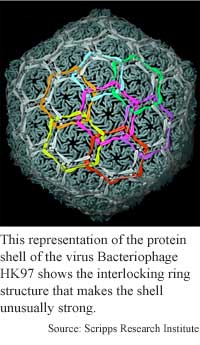
Sturdy virus makes tiny container
By Eric Smalley, Technology Research NewsResearchers have discovered that a bacteria-infecting virus has a uniquely strong protein shell, making it a good candidate to serve as a nanoscale container for storing and transporting tiny amounts of substances.
The head of bacteriophage HK97 is a 66-nanometer-diameter ball composed of 60 hexagons and 12 pentagons that form 72 interlocking protein rings. The rings are cross-linked via strong, covalent chemical bonds.
This structure allows the virus to withstand harsh conditions like heat or denaturing solvents, which cause typical viruses to fall apart relatively easily, said William R. Wikoff, a postdoctoral research associate at the Scripps Research Institute.
"The proteins form these rings and then those rings loop together, like the Olympic rings," he said. "It's this interweaved grid of proteins that's incredibly stable."
Viruses are made up of strands of nucleic acid -- either DNA or RNA -- surrounded by a protein coat. A virus replicates by infecting a cell of an organism and appropriating the cell's mechanism for copying DNA. The new copy of the virus's nucleic acid forms an empty protein coat, or capsid, and then enters the capsid, completing the replication cycle. The empty capsid is called a procapsid, Wikoff said.
HK97's procapsid has holes 1 to 1.5 nanometers in diameter. Researchers could fill it by simply flooding it with a substance, then lowering the pH level to cause the procapsid to mature into a closed capsid, Wikoff said. The HK97's cross-linking occurs automatically, he said.
"You can think of it very simply as a pot with a lid," Wikoff said. "In the procapsid you have the lid off. In the mature capsid you have the lid on. Because of this cross-linking, [the lid] is very tight. It's kind of welded on. And that's completely different from what we see in any other virus. So it's a very stable and strong container."
One potential application is as a drug delivery mechanism, Wikoff said. HK97 could be used as a nanoscale container now, he said.
The researchers published their work in the September 22, 2000 issue of the journal Science. Wikoff's colleagues were John E. Johnson of Scripps, Hiro Tsuruta of Stanford University, Lars Liljas of the University of Uppsala, and Robert L. Duda and Roger W. Hendrix of the University of Pittsburgh. The research was funded by the National Institutes of Health.
Timeline: Now
Funding: Government
TRN Categories: Nanotechnology
Story Type: News
Related Elements: Technical paper "Topologically Linked Protein Rings in the Bacteriophage HK97 Capsid" in September 22, 2000 Science
Advertisements:
September 27, 2000
Page One
Ants solve tough problems
Camera gets all the exposure
Coated specks form nano building blocks
Sturdy virus makes tiny container
Freezing speeds rapid prototyping

News:
Research News Roundup
Research Watch blog
Features:
View from the High Ground Q&A
How It Works
RSS Feeds:
News
Ad links:
Buy an ad link
| Advertisements:
|
 |
Ad links: Clear History
Buy an ad link
|
TRN
Newswire and Headline Feeds for Web sites
|
© Copyright Technology Research News, LLC 2000-2006. All rights reserved.